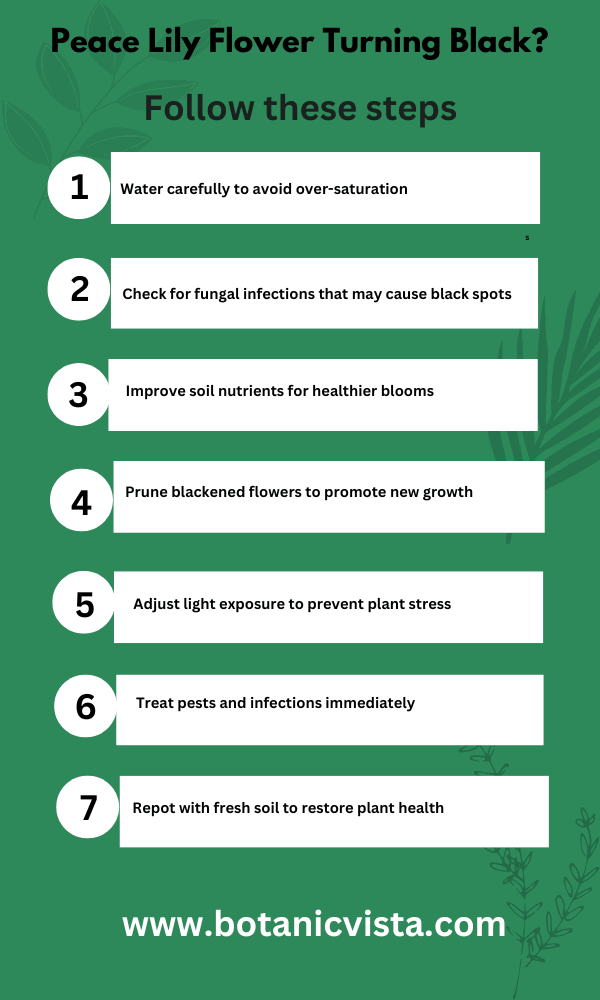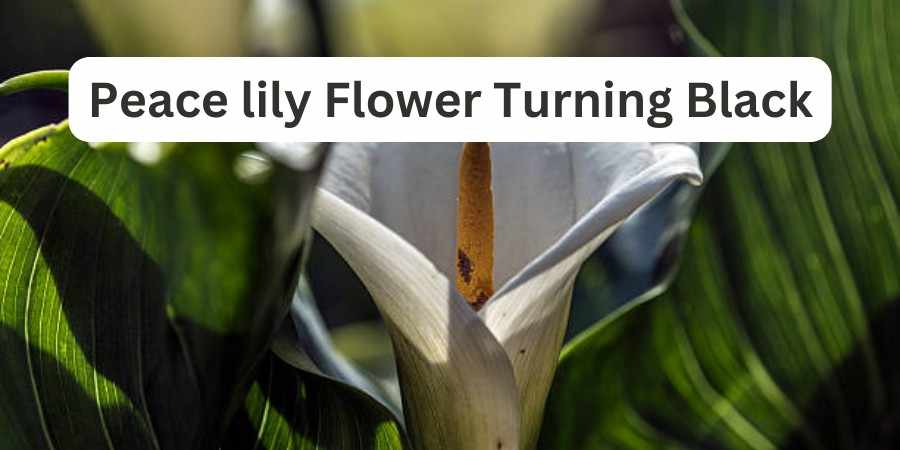Last Updated on October 14, 2024 by Jocelyn
It can be quite alarming if you’ve noticed that your Peace Lily flower is turning black. But don’t worry—this is something that many plant owners face and is usually fixable.
You see, Peace Lilies are known for their striking white spathes, so when they start to turn black, it’s a clear sign that something isn’t right. But by identifying the cause, you can take steps to save your plant and bring it back to health.
Now, let’s talk about what might be going wrong. Often, the black color appears due to over-fertilization. When you add too much fertilizer, it can harm the leaves and flowers, causing them to darken.
So, what should you do? First, cut back on the fertilizer. Make sure you’re using the right amount because too much can be just as bad as too little.
Additionally, overwatering is another common issue. While Peace Lilies love humidity and need consistent water, too much of it can lead to root rot and, you guessed it, a black flower.
To prevent these problems in the future, it’s all about balance. Place your Peace Lily in a spot with indirect light, and be sure to use well-draining soil. Also, don’t forget to check for pests regularly—an unnoticed infestation can quickly lead to black flowers too.
In this article, we will discuss the causes, solutions, and preventive measures to help you keep your Peace Lily healthy.

Table of Contents
ToggleWhat Causes Peace Lily Flowers to Turn Black?
Peace lilies are popular houseplants that require specific conditions to remain healthy. However, sometimes their flowers can turn black, which can be concerning. Understanding the causes of this issue is crucial for maintaining the beauty of your flowers. Let’s discuss in detail the main causes.
Incorrect Watering
Peace lilies need consistent moisture, but overwatering can lead to waterlogged soil, causing flower discoloration and blackening. It’s important to keep the soil slightly moist, not soggy, to prevent these issues. Conversely, under-watering can also damage the flowers, leading to black spots or complete blackening.
Fungal Infections
Fungal infections are a common cause of black flowers in Peace Lilies. Pathogens like Cylindrocladium and Pythium thrive in overly moist environments and can attack the flowers directly, causing them to turn black. Keeping the flowers dry and providing good air circulation helps in reducing the risk of fungal infections.
Nutrient Deficiencies
A lack of essential nutrients, particularly phosphorus and potassium, can lead to blackening flowers. These nutrients are crucial for the development of healthy blooms. If the flowers are turning black, consider adjusting the fertilizer to include these nutrients.
Poor Pollination
In some cases, poor pollination can lead to flowers turning black. This is particularly relevant if the plant is indoors and isolated from pollinators. Ensuring that the plant is in a well-ventilated area or manually assisting with pollination can help prevent this issue.
Pests
Pests such as aphids, spider mites, and mealybugs can cause significant damage to Peace Lily flowers. These pests suck the sap from the plant, leading to weakened and discolored flowers, eventually causing them to blacken. Regular inspection and prompt treatment can help keep these pests at bay.
Poor Water Quality
Using chlorinated or overly salty water can lead to blackened flowers. Peace Lilies prefer clean, toxin-free water. Switching to filtered or distilled water can prevent further damage to the flowers.
Cold Injury
Exposure to cold drafts or temperatures can cause flowers to turn black. Peace Lilies prefer warm, stable environments. Keeping the plant away from cold air and ensuring a consistent temperature will help in avoiding cold stress.
Overfertilization
Excessive use of fertilizers can cause a buildup of salts in the soil, which in turn can lead to black flowers. It’s advisable to use fertilizers sparingly and choose a balanced mix that provides essential nutrients without overwhelming the plant.
Low Humidity
Peace Lilies thrive in humid conditions, and low humidity can cause stress. Increasing humidity around the plant by misting or using a humidifier can help maintain healthy blooms.
Light Issues
Flowers may turn black due to too much direct sunlight or insufficient light. Peace Lilies need bright, indirect light. Placing them in a well-lit area without direct exposure to the sun can prevent light-related damage.
How to Fix Black Flowers in Peace Lilies?
When you notice your Peace Lily’s flowers darkening, it’s important to tackle the issue promptly. Here are essential tips to help bring your plant back to its best!
1. Check the Soil and Watering
Ensure the soil has good drainage to prevent water from accumulating. Overwatering can lead to fungal infections and root rot, causing the flowers to turn black. Allow the soil to dry out slightly before the next watering.
2. Prune the Affected Flowers
Carefully prune any flowers that are turning black. This stops the spread of potential infections and encourages the growth of new, healthy blooms.
3. Adjust Light Conditions
Move the plant to a location with bright, indirect light. Avoid direct sunlight, which can burn the flowers, and keep the plant away from cold drafts.
4. Treat Infections
Apply neem oil or a mild insecticidal soap to treat any fungal or pest-related issues. Reducing the use of chemical insecticides can also help prevent adverse effects on the plant.
5. Repot if Necessary
If the soil is depleted or contaminated with salts, repotting the plant in fresh soil can give it a new lease on life. Choose a pot with adequate drainage and use high-quality soil.
Explore more for expert advice on tackling various plant concerns:
- Fungal Leaf Spot Monstera
- Snake Plant Root Rot
- Yellow leaves on olive tree
- How to Fix Monster Brown Leaves
Preventive Measures
To keep your peace lily healthy, avoid overwatering and provide enough indirect sunlight. These simple steps can help prevent those black spots. Check out the table below for easy preventive measures you can start today.
| Step | Details |
| Watering Frequency | Water once a week to keep the soil just moist enough. |
| Sunlight | Place in bright, indirect light to avoid leaf burn. |
| Soil Type | Choose a well-draining soil mix to prevent waterlogging. |
| Drainage | Make sure your pot has good drainage to avoid root rot. |
| Temperature | Keep it in a warm spot, away from drafts. |
| Nutrient Addition | Add organic materials like eggshells to boost soil nutrients. |
| Pest Control | Regularly check for pests and gently wash leaves if needed. |
FAQ’s
Q: Why Are My Peace Lily Blooms Turning Black?
A: Peace lily blooms turning black can mean they’re spent or have bacterial or fungal issues. Blackened blooms usually occur when the plant is overwatered or if there’s an infection. To keep the lily healthy, ensure proper care to prevent decline.
Q: Do You Cut off Dead Peace Lily Flowers?
A: When peace lily flowers turn brown or black, it’s a good idea to snip them off. Use a sharp pair of secateurs or scissors to cut the dead blooms at the base. This keeps your lily plant healthy and encourages new flowers to grow.
Q: How to Treat Black Spots on Peace Lily Flower?
A: Black spots on your Peace Lily might be a sign of pests or overwatering. Use insecticidal soap or neem oil for treatment and avoid overwatering to keep these uninvited guests away.
Q: How Much Light Does a Peace Lily Need?
A: Peace lilies need indirect sunlight to stay healthy. If they get direct exposure, their leaves may scorch and turn black. Place the plant in a bright room but avoid prolonged sunlight. They can live in a dark corner, but flowers might not bring their perfect life without enough light.
Q: Why Are the Tips of My Peace Lily Turning Black?
A: It’s usually due to improper watering, over-fertilization, or pest infestations. These problems can also cause fungus infections in the soil. Identifying these issues early and taking the right steps will help save the plant from further damage.
Conclusion
When a peace lily flower turns black, it can be concerning. This might happen due to overwatering, low humidity, or too much direct sunlight. If you see black spots, check the soil. Is it too wet? Peace lilies prefer moist but not soggy conditions. Adjust the watering routine to see improvement.
Sometimes, the blackening is due to cold drafts or aging flowers. In these cases, move the plant to a warmer spot or trim the old flowers. This way, your peace lily stays healthy.
If the plant’s leaves are also turning black, it might be a sign of root rot. Make sure the pot has good drainage. Let the soil dry out a bit before the next watering. Also, avoid placing the plant in a spot with strong sunlight.
A little care can keep your peace lily looking fresh and green. Take action today to save your peace lily and keep it healthy!

